THE EFFORTI FRAMEWORK
- Overview
- Objectives
- Inputs
- Implementation Activities
- Outputs, Outcomes & Impacts
- Factors Policy Context
- Factors Organizational Context
- Factors Team Context
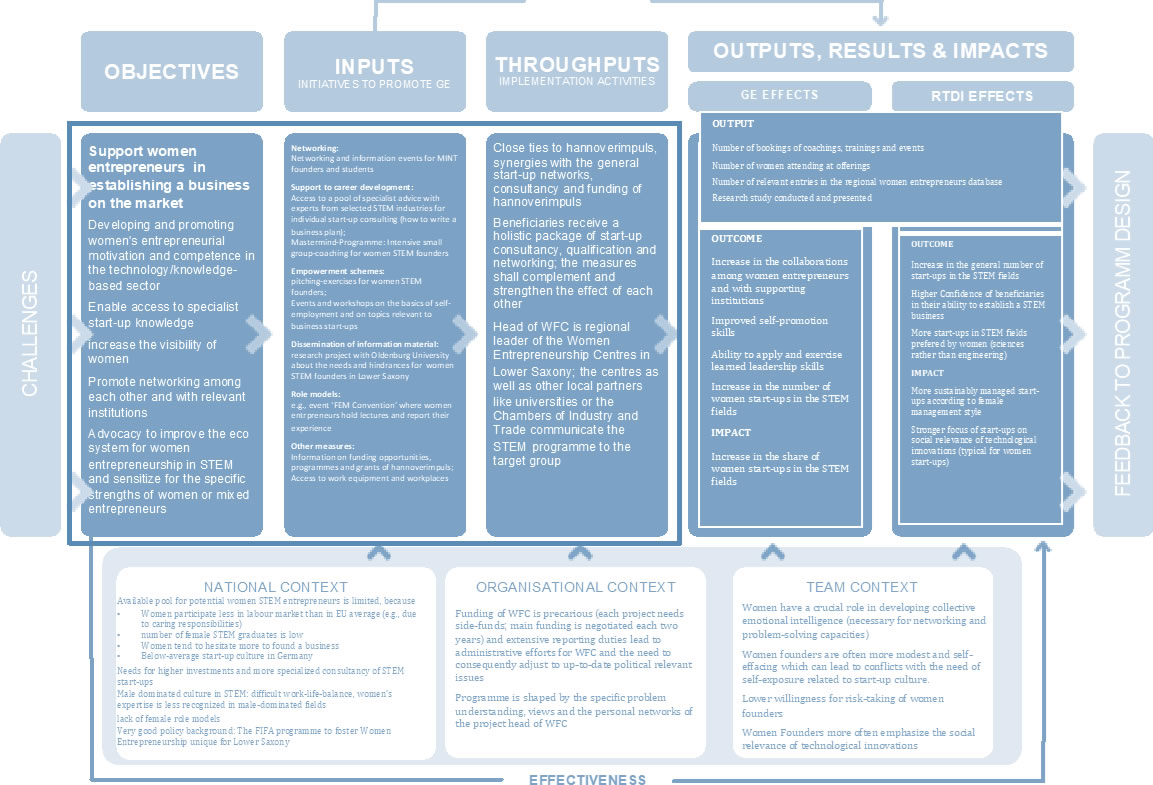
Introduction to the EFFORTI framework
Evaluation Framework for Promoting Gender Equality in Research and Innovation
Practical Guide
EFFORTI is a novel framework that enables a wide range of stakeholders - ministries, funding agencies, programme owners, equality officers etc. - to conduct a sound and comprehensive evaluation of the gender equality but also research and innovation outputs, outcomes and impacts of gender equality (GE) measures.
What makes this framework unique in its field is its methodologically rich and thorough theoretical foundation that enables to model practice-relevant policies by taking into consideration the unique interactive dynamics in a specific context. In its European-wide research and case study work, the EFFORTI project has generated a significant source of evidence on potential impacts of all aspects of GE for society, the economy and science - thereby targeting/responding to societal needs and contemporary grand challenges.
This framework provides you with a sophisticated, holistic and comprehensive tool that you can use to document and analyze how gender equality (GE) related interventions contribute to the achievement of gender equality objectives like more women in R&D, more women in leadership, and integrating the gender dimension in research at different levels of observation (team, organisation, country). Furthermore, it allows you to reflect potential changes on research and innovation processes and outcomes too.
In the following, you will be guided through the key components of the EFFORTI intervention logic model. It represents the basis for a step-by-step planning of your own, tailored policy design and / or evaluation by providing you with a both holistic and nuanced approach.
Taking your GE related objectives as a starting point, all steps on the horizontal axis – inputs, implementation activities, and outputs, outcomes, impacts – can be differentiated along three levels (team, organizational and country level), allowing a comprehensive multi-level perspective on identifying results of an intervention or policy measures and its preceding impacts pathways.
What adds to this model’s unique character is its consideration of potential contextual influence factors, which are also levelled along a team, organizational and national context. The consideration of context factors emphasizes the frameworks’ dynamic, responsive nature and enables a more comprehensive and systemic depiction of the complex link between gender equality measures and research and innovation results.
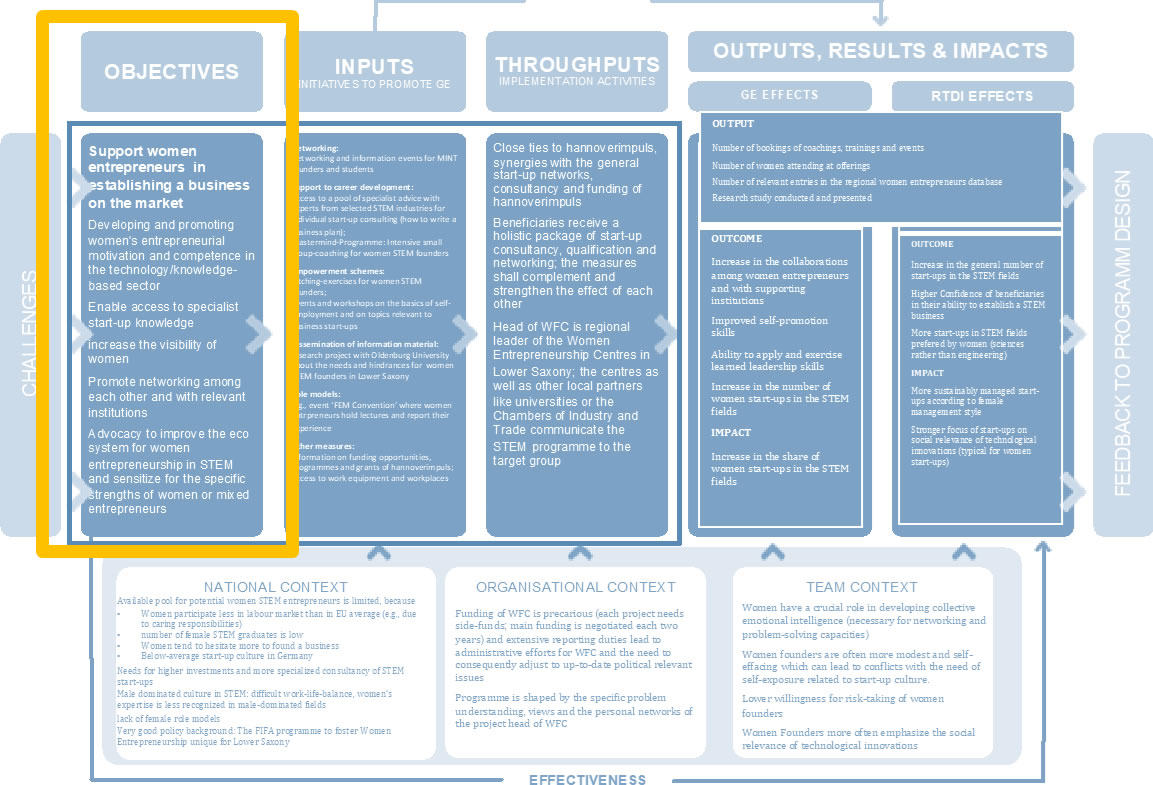
Objectives
An objective is the goal or aim of the intervention / measure / programme. Starting from the three gender equality objectives of the European Research Area (more women in research and innovation, more women in leadership positions and the integration of gender dimensions in research and innovation content), typical objectives of a GE intervention in the EFFORTI context may be the following ones:
Example
- Improve working conditions / work-life balance
- Boost professional capabilities of women to pursue promotion
- Implement gender-fair organizational structures
- Integrate the gender dimension in research and teaching
- Foster RRI (ethics, public engagement, science education, open access and/or governance)
- Increase research/innovation/economic outputs and impacts
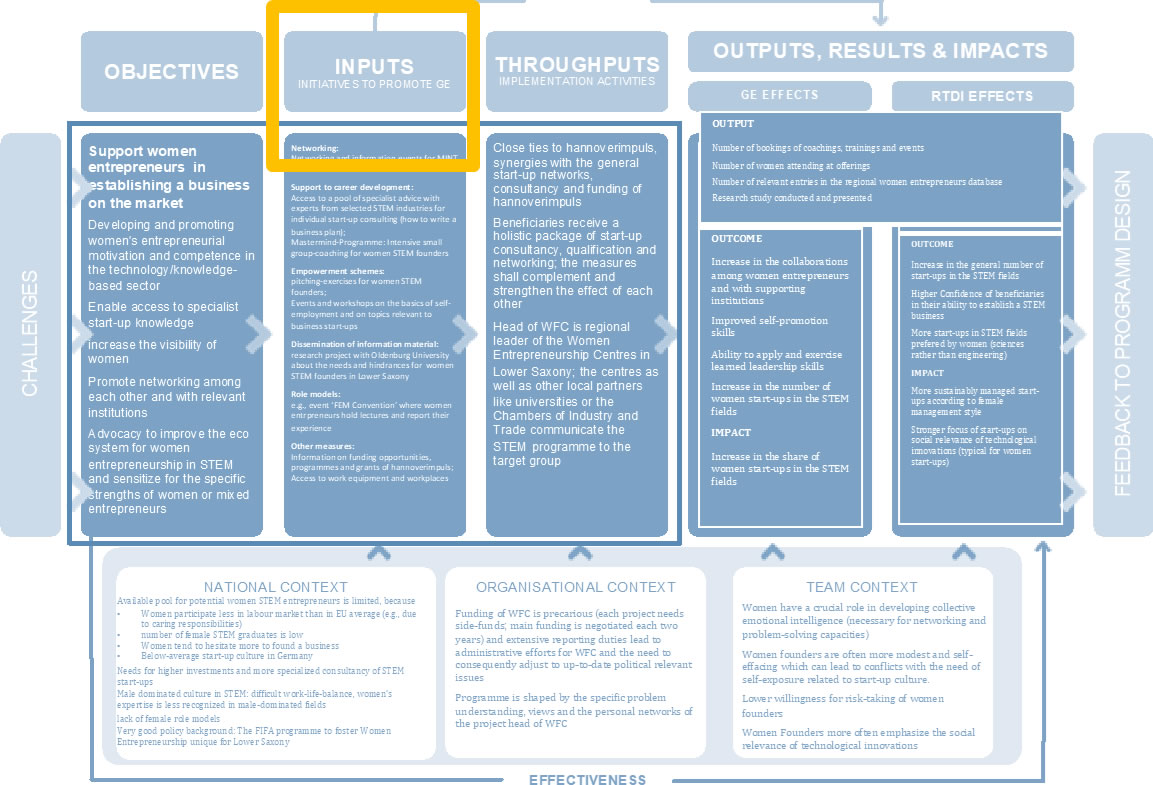
Inputs
In the context of EFFORTI, we use a simplified I-O-O-I model that stands for "Input-Output-Outcomes-Impacts". These four categories vary with respect to their time frame (short-, mid-, long-term), their scope/level (team, organizational, national or supranational) and target groups (beneficiaries of an intervention or beyond).
Example
The most common inputs for a policy intervention like a mentoring programme are
- Financial resources
- Human resources
- Access to infrastructure
- Information
Inputs can be delivered by a programme owner or by the beneficiary of the programme (an individual an organisation). For example, a mentoring programme can offer regular meetings between mentor and mentee, workshops etc.

Implementation Activities
Implementation activities describe the concrete support and activities which make possible to perform/realize the intervention. They can take place by providing concrete financial resources, information or rules.
Example
An implementation activity may be
- the assignment of a responsible person or organizational unit
- information events
- the definition of a concrete budget
- the definition of concrete operational goals and milestone plans
- the establishment of a monitoring system
- etc.
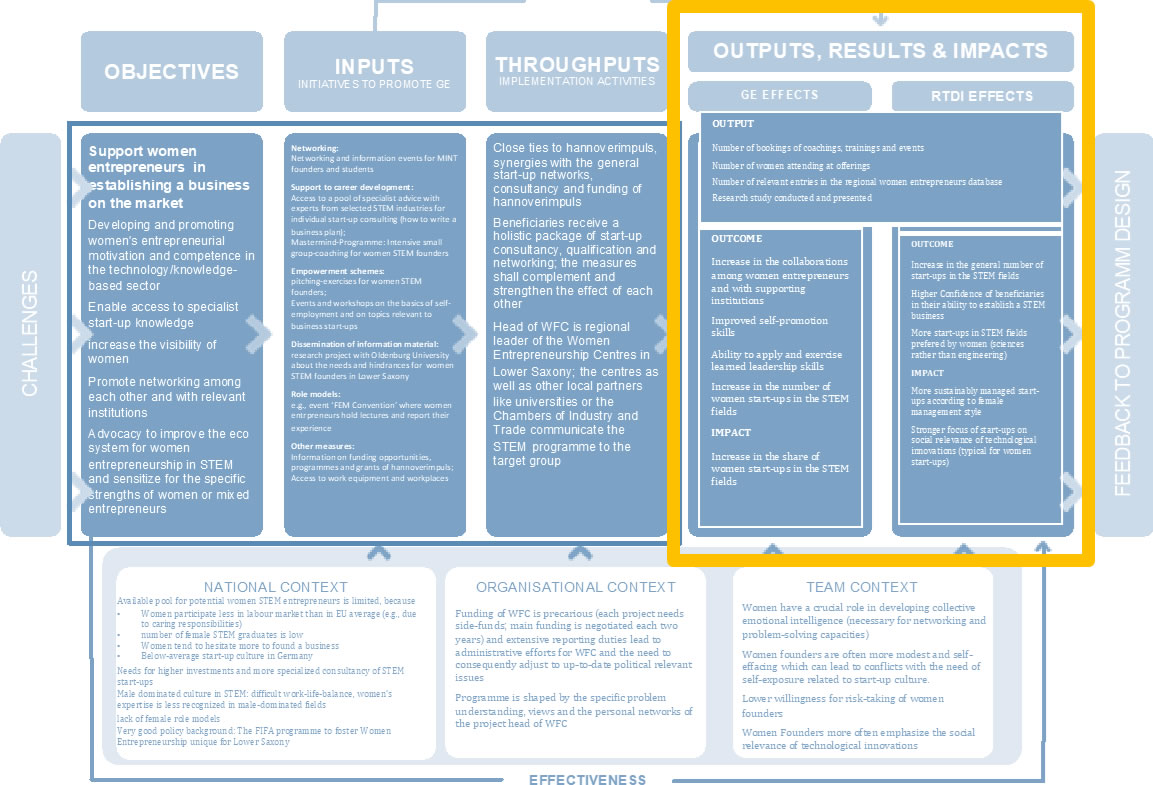
Output, Outcomes and Impacts
Outputs, outcomes and impacts represent key parts of the I-O-O-I (input-output-outcome-impact) model and can be described as the results or effects of a GE intervention. Beyond time frame, level and target group, these can be furthermore grouped into direct or indirect as well as intended or unintended effects.
- Outputs: Short term (measurable results) of funded projects / programmes
- Outcomes: Mid-term effects on the participants/beneficiaries of the programme
- Impacts: Mid- or long-term indirect effects that occur beyond the participants of a programme/spill-overs
Please note that you might expect not only gender equality effects as changes with regard to the gender equality interventions but also changes of research and innovation processes and outputs / outcomes and impacts.
Examples for I-O-O-I dimensions are:
- Improve working conditions / work-life balance
- Boost professional capabilities of women to pursue promotion
- Implement gender-fair organizational structures
- Integrate the gender dimension in research and teaching
- Foster responsible research & Innovation (e.g. ethics, science education)
- Increase research/innovation/economic outputs and impacts
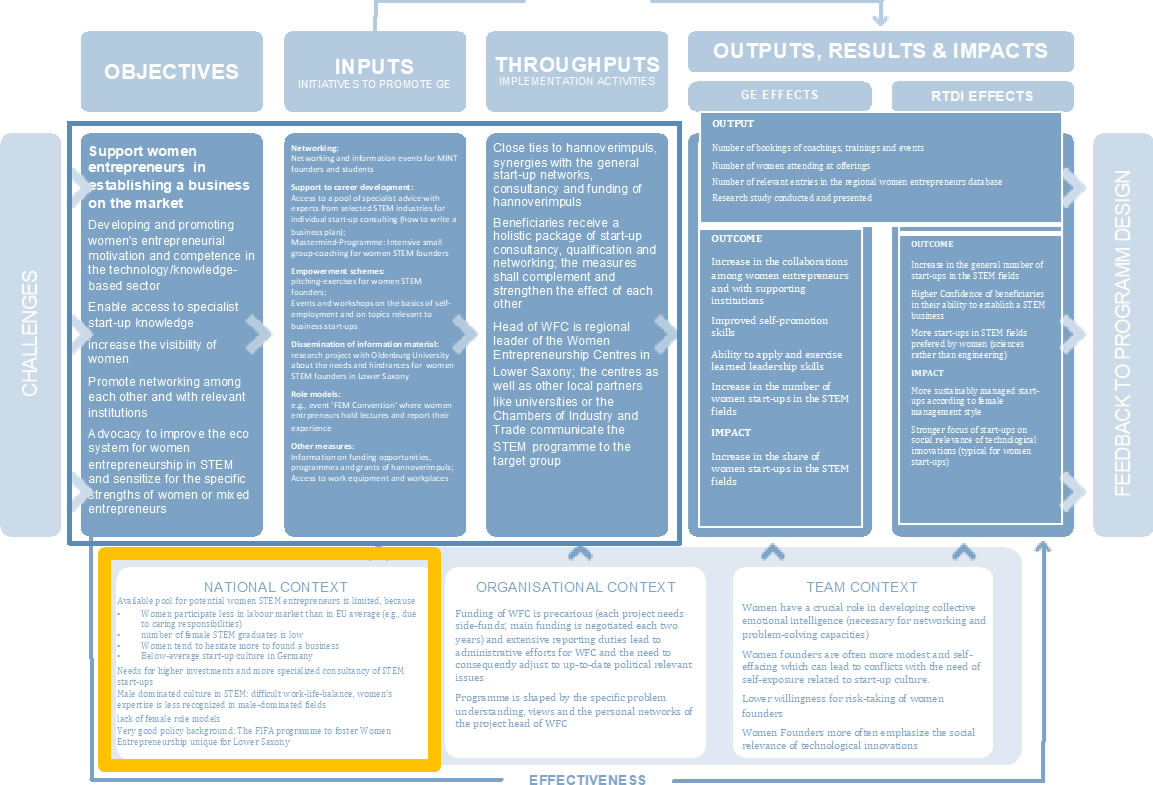
Policy Context
By policy context we mean the national or European framing conditions in force, which we expect to have an influence on the effectiveness and efficiency of equality policies.
Example
Typical policy context factors are:
- structure and competitiveness of the national research and innovation systems
- structure and main components of the welfare systems
- labour market characteristics
- existing gender equality policies including legislative meaures
- participation of women in tertiary education
- horizontal and vertical segregation
- gender pay gap
- women in decision-making positions
- evaluation cultures and policies
When using the toolbox, you are free to indicate two types of factors that apply to your specific policy/national context:
- the main national contextual factors that may shape the implementation of your intervention thereby affecting impact
- the facilitating or hindering factors at the policy/national level that might have an impact on your intervention.
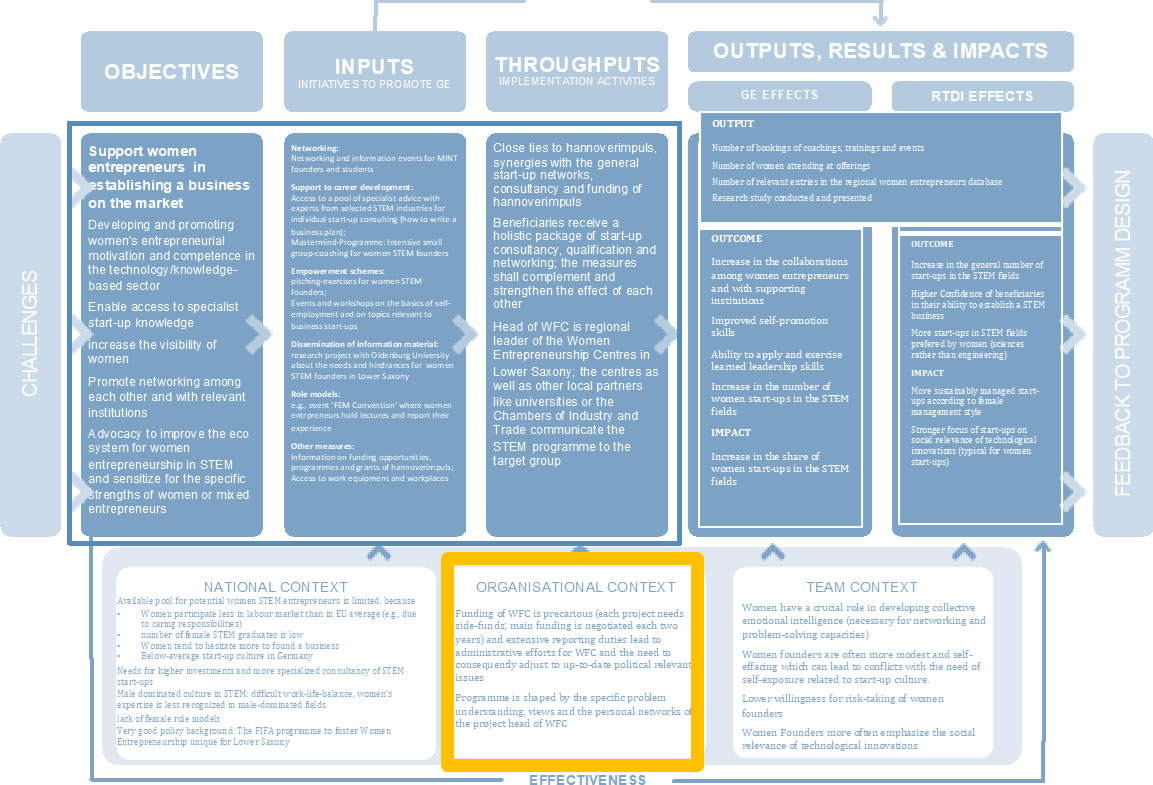
Organizational Context
By organizational context, we mean all structures, characteristics and further measures of an organization that can have an influence on equality measures.
Example
Organizational context factors are, for example:
- Type of institution (Uuniversity, company, public administration etc.)
- Structure (sub-units, hierarchical levels, etc.)
- Size (from small start-up companies up to large-scale research organisations)
- Mission
- Governance mechanisms (hierachical, bottom-up desicion making, soft or hard governance, composition of the decision-making bodies)
- Resources / Budget (public / private)
When using the toolbox, you are free to indicate two types of factors that apply to your specific organizational context:
- the main organizational factors that may shape the implementation of your intervention thereby affecting impact
- the facilitating or hindering factors at the organizational level that may shape the implementation of your intervention thereby affecting impact.
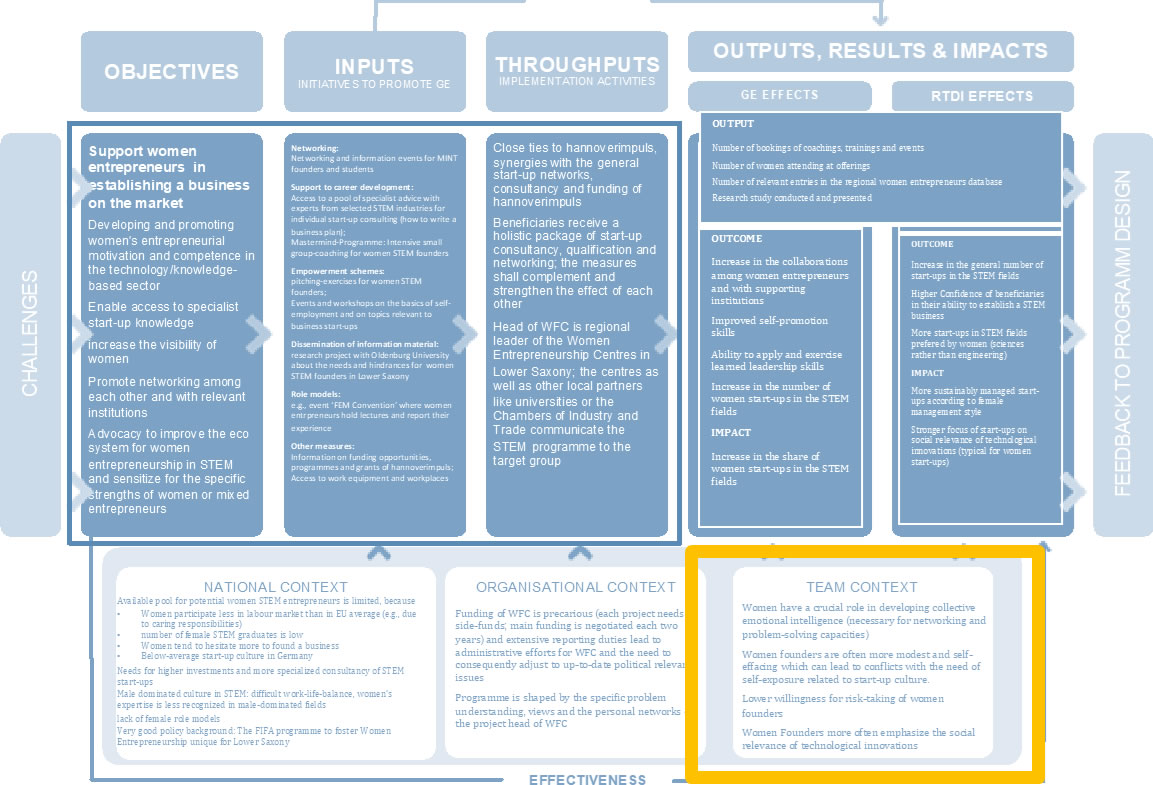
Team context
Team context comprises all structures, characteristics and further measures related to a research/innovation team’s composition that can have an influence on the effectiveness and efficiency of GE measures
Example
The Spanish team identified the following team dimensions:
- Gendered competency expectations
- Level of team deference
- Scale of empathy
- Gender balance in research team/research team composition
- Power relations at the team level
- Acknowledgement of gender issues in the team
- Perceived extent and pace of cultural change at the team level
When using the toolbox, you are free to indicate two types of factors that apply to your specific team context:
- the main team factors that hindered/supported the impacts of the intervention
- the facilitating or hindering factors at the team level that may impact your intervention
THE EFFORTI TOOLS

Programme Theory Generator
Create and visualize your own programme theory using the EFFORTI template

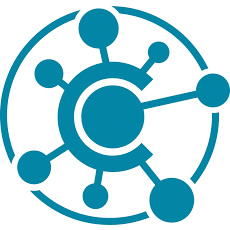

 This project has received funding from the European Union's Horizon 2020 research and innovation programme under grant agreement No. 710470
This project has received funding from the European Union's Horizon 2020 research and innovation programme under grant agreement No. 710470